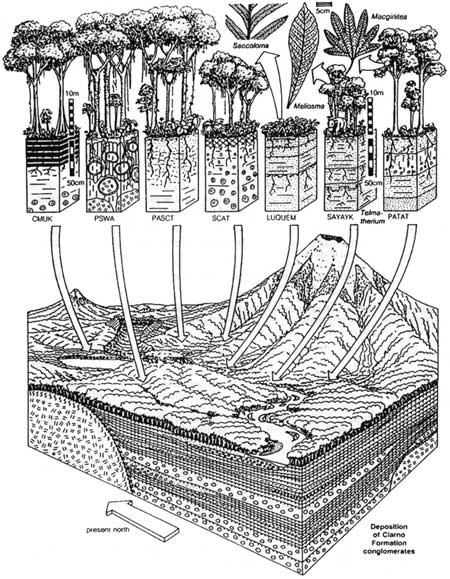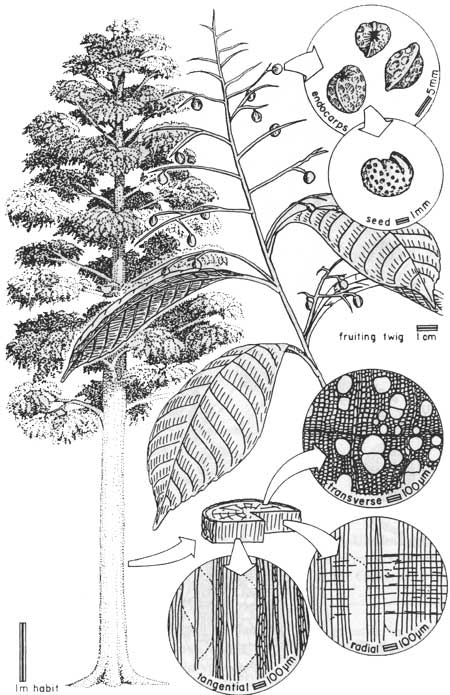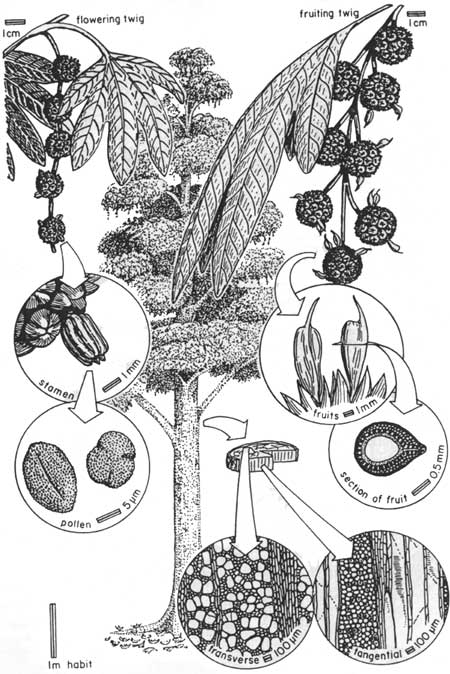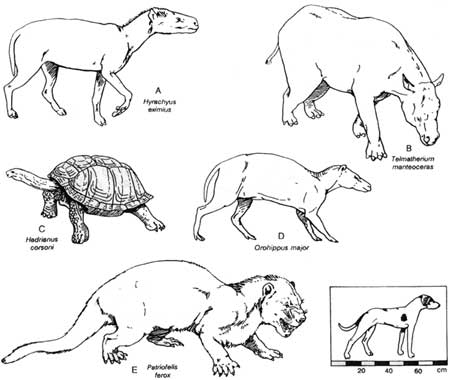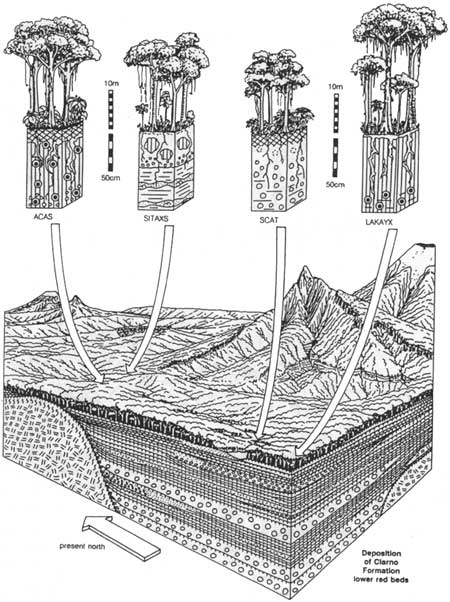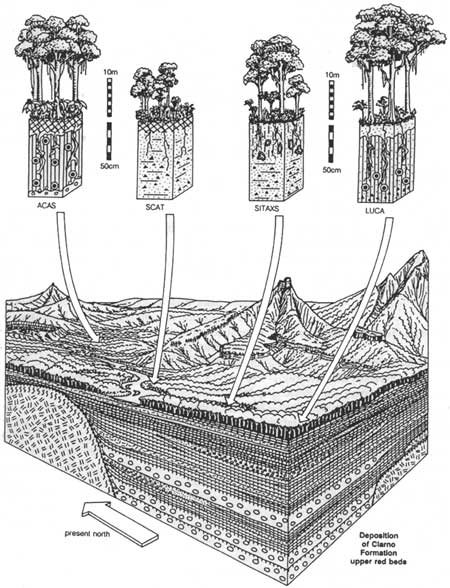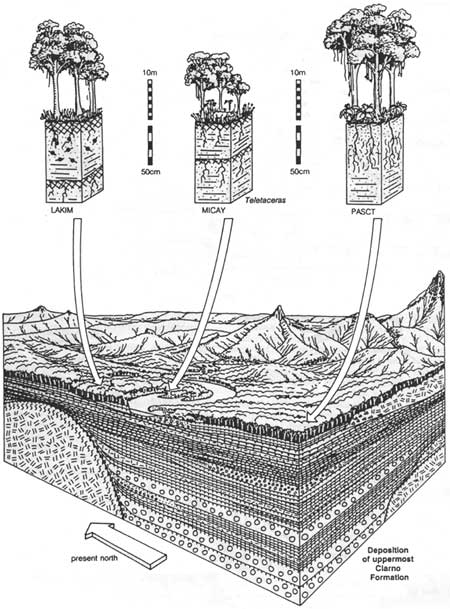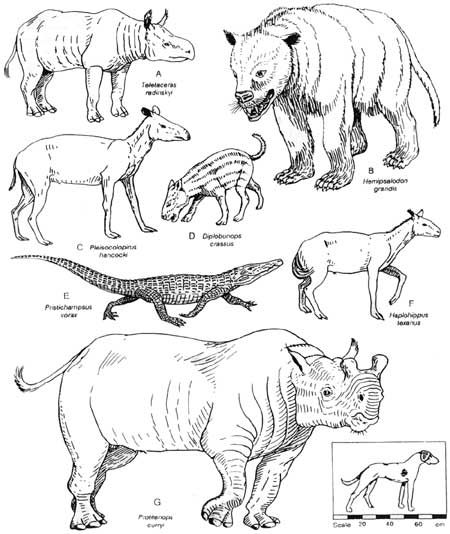|
JOHN DAY FOSSIL BEDS
Geology and Paleoenvironments of the Clarno Unit John Day Fossil Beds National Monument, Oregon |

|
CHAPTER IV:
PALEOENVIRONMENTAL SUMMARY OF THE CLARNO AREA
Each paleosol has something to offer in terms of paleoenvironmental information, as summarized in Tables 3.1 and 4.1, but much can also be gained by considering assemblages of paleosols from different levels of the sequence as parts of a sequence of varied ancient landscapes. These reconstructed landscapes can then be compared with modern landscapes and their soils. The potential interrelationship between paleosols can be explored by plotting them in two dimensions with hue as the dependent variable and degree of development as the independent variable (Fig. 4.1). Broad classes of hue reflect degree of drainage and humification. Development on the other hand reflects time for formation of the paleosol and stage of ecological succession of its vegetation. Thus weakly developed paleosols can be considered precursors to better developed paleosols on the same general parent material and in the same general paleotopographic setting. Although weakly developed soils dominate many depositional settings, the less-common better-developed paleosols probably reflect more accurately conditions over most of the landscape.
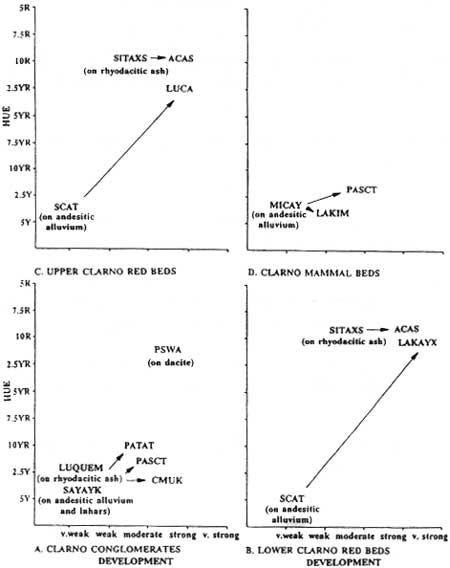
|
| Figure 4.1. Interpretive relationships between late Eocene paleosols from (A) "Nut Beds" and conglomerates, (B) lower red beds, (C) upper red beds and (D) brown siltstones of "Mammal Quarry" in the upper Clarno Formation, in terms of likely former degree of drainage and humification (red versus drab hue) and duration of soil development (weak versus strong development), and likely direction of ecological succession of plants and of soil development (arrows). |
TABLE 4.1 - INTERPRETED MID-TERTIARY PALEOENVIRONMENTS OF NAMED PEDOTYPES
| PALEOSOL | PALEOCLIMATE | ANCIENT VEGETATION |
| Acas | Humid (>1000 mm m.a.p.), seasonally dry | Lowland well-drained old-growth forest: no fossils found |
| Cmuk | Not sufficiently well drained to reflect paleoclimate | Swamp woodland: from "Black Spur" (L1757) including laurel (Litseaphyllum presanguinea), aguacatilla (Meliosma sp. cf. M simplicfolia), and broadleaf grass (Graminophyllum sp. indet.) |
| Lakayx | Humid (1000-2000 mm m.a.p.) | Lowland well-drained old-growth rain forest: no fossils found |
| Lakim | Insufficiently developed indicator | Lowland seasonally inundated swamp forest: no fossils found |
| Luca | Humid (1000-1500 mm m.a.p.), seasonally dry | Lowland well-drained old-growth forest: at "Whitecap Knoll" (L1358) charred wood of dicotyledonous angiosperm |
| Luquem | Insufficiently developed indicator | Early successional herbs: in "Fern Quarry" (L1099) and "Nut Beds" (L748) mainly fern (Saccoloma gardneri) with some horsetail (Equisetum clarnoi) |
| Micay | Insufficiently developed indicator | Early successional vegetation: in "Mammal Quarry" (L775) may have yielded assemblage of tropical fruits and seeds and in John Day Formation (L1777) yields coniferalean wood |
| Pasct | Humid (>1000 mm m.a.p.) | Lowland poorly-drained forest: no fossils found |
| Patat | Insufficiently developed indicator | Mid-successional colonizing forest: in lahars to west (L750, L1731, L1733, L1754) includes sycamore (Macginitea angustiloba), katsura (Joffrea speirsii), alder (Alnus clarnoensis) and laurel (Cinnamomophyllum sp. cf. "Cryptocarya" eocenica): but in "Nut Beds" and lahars to east (L1756) includes aguacatilla (Meliosma sp. cf. M. simplicifolia), magnolia (Magnolia sp. cf. M. leei), walnut (Juglans sp. indet.) and sycamore (Macginitea angustiloba) |
| Pswa | Humid (>1000 mm m.a.p.), seasonally dry | Well-drained old-growth forest: no fossils found |
| Sayayk | Insufficiently developed indicator | Early successional pole woodland: many localities in "Nut Beds" (L1359) and western lahars (L1730, L1759, L1761, L1854, L1855, L1856, L1857, L1859, L1860, L1861, L1873) with diverse flora of tropical affinities including aguacatilla (Meliosma sp. cf. M. simplicifolia), moonseed (Diploclisia), icacina vine (Goweria dilleri), magnolia (Magnolia leei), laurels (Litseaphyllum praesanguinea, L. praelingue, L. sp. cf. "Laurophyllum" merrilli, Cinnamomophyllum sp. cf. "Cryptocarya" eocenica). tree fern (Cyathea pinnata), horsetail (Equisetum clarnoi) walnut (Juglans sp.), maple (Acer clarnoense), alder (Alnus clarnoensis), katsura (Joffrea speirsii) and sycamore (Macginitea angustoloba); but in lahars to east (L1650, L1732, L1753, L1760, L1858) have limited flora of temperate affinities including sycamore (Macginitea angustiloba), katsura (Joffrea speirsii), alder (Alnus clarnoensis), laurel (Litseaphyllum presanguinea), and horsetail (Equisetum clarnoi) |
| Scat | Insufficiently developed indicator | Humic mid-successional woodland |
| Sitaxs | Insufficiently developed indicator | Seasonally waterlogged lowland colonizing forest. |
| FORMER ANIMALS | TOPOGRAPHY | PARENT MATERIAL | TIME FOR FORMATION | PALEOSOL |
| No fossils found | Seasonally inundated lowland | Weathered andesitic gravel and volcanic ash | 10-60 Ka | Acas |
| No fossils found | Swampy lowland, water impounded around local andesitic dome | Andesitic sand and silt | 0.4-4 Ka | Cmuk |
| Burrows of beetles and termites | Well drained terraces of alluvial lowland to lower slopes of an old volcano | Andesitic gravel and rhyodacitic volcanic ash | 30-150 Ka | Lakayx |
| No fossils found | Seasonally inundated alluvial levee and lowland | Fluvially redeposited andesitic gravel and rhyodacitic volcanic ash | 0.5-1 Ka | Lakim |
| "Whitecap Knoll" (L1358): hog (Entelodontidae gen. et sp. indet.) | Well drained terraces of alluvial lowland | Rhyodacitic volcanic ash | 40-130 Ka | Luca |
| No fossils found | Well drained near stream terraces of volcanic apron | Rhyodacitic volcanic ash | 1-10 yr | Luquem |
| "Mammal Quarry" (L775): fish, alligator (Pristichampsus sp.), bearlike creodont (Hemipsalodon grandis), sabre-tooth cat (Nimravinae), rodent, anthracothere (Heptacodon sp.), oreodon (Diplobunops sp.), rhinoceroses (Teletaceras radinskyi, Procadurcodon sp.), tapir (Plesiocolopirus hancocki, Protapirus sp.) and horses (Epihippus gracilis, Haplophippus texanus) | Levee of stream draining apron of moribund volcanic edifice | Fluvially redeposited andesitic gravel and rhyodacitic volcanic ash | 0.1-2 Ka | Micay |
| No fossils found | Imperfectly drained floodplain of volcanic apron | Fluvially redeposited andesitic gravel and rhyodacitic volcanic ash | 10-60 Ka | Pasct |
| No fossils found | Levee of lahar runout streams on volcanic apron | Fluvially redeposited porphyritic andesite gravel and sand | 50-100 yr | Patat |
| No fossils found | Colluvial talus of old volcanic dome of porphyritic andesite | Breccia of porphyritic andesite | 40-150 Ka | Pswa |
| No fossils found | Levee of volcanic lahar runout streams | Fluvially redeposited andesite gravel and sand | 1 - 10 yr | Sayayk |
| No fossils found | Alluvial terraces and volcanic mudflows | Andesitic gravel and sand, also rhyodacitic tuffs | 0.1-1 Ka | Scat |
| No fossils found | Low lying volcanic tuffs | Rhyodacitic tuffs | 0.1-1 Ka | Sitaxs |
Deposition of Clarno volcaniclastic deposits
From this perspective the suite of paleosols within Clarno Formation conglomerates some 44 million years ago (Fig. 4.2) is comparable with soils forming now around central American andesitic stratovolcanoes. Volcanoes south of Mexico and into Guatemala and Nicaragua are associated with soils more strongly weathered (Nitosols and Ferralsols of F.A.O, 1975) than those of the Clarno Formation (Acrisols and Luvisols), whereas in northern Mexico the best developed soils are less deeply weathered (Luvisols and Cambisols). Soils around the volcanoes of the Transmexican Volcanic Belt match Clarno paleosols well, and particularly those around San Martin Volcano in the Sierra de los Tuxtlas near the Gulf of Mexico in Veracruz state, Mexico (F.A.O. 1975 map unit Tv 17-2ab). The volcano is on the boundary between two climatic and vegetation zones. At low elevations climate is seasonally dry humid tropical, with mean annual rainfall of more than 2500 mm and a dry season of up to 3 months. Mean annual temperature is more than 23°C and mean annual range of temperature is 8°C. At higher elevations and to the north climate is humid tropical with a more marked dry season of 4-6 months, mean annual rainfall of 1250-2000 mm, mean annual temperature of more than 23°C and mean annual range of temperature of 8°C. This climatic boundary is also the boundary between evergreen tropical forest and semideciduous forest ("selva alta perennifolia" and "selva alta subperennifolia" of Mata and others, 1971). The most conspicuous elements of the evergreen lowland forest are ramon breadnut tree (Brosimum alicastrum), sapodilla (Manilkara zapota), tempisque (Sideroxylon tempisque), mahogany (Swietenia macrophylla), white mangrove (Bucida buceras), capiri (Masticodendron capiri), Mirandaceltis monoica and Carpodiptera floribunda (F.A.O. 1975). This lowland vegetation passes upwards at elevations of 700-900 m to a diverse tropical forest rich in species of the family Lauraceae, hence the term "selva of Lauraceae". Common in this semi-evergreen forest are Christmas tree (Alchornea latifolia), bolly gum (Beilschmiedia anay, B. mexicana), icaeina vine (Calatola laevigata), cycad (Ceratozamia mexicana), tree fern (Cyathea mexicana), indigo bush (Dalea elata), leguminaceous tree (Dussia mexicana), fig (Ficus lapathifolia), cocoa-relative (Hampea integerrima), tropical laurel (Licaria peckii), melastoma-relative (Miconia trinervis), tropical hackberry (Mirandaceltis monoica), silverballi (Nectandra salicifolia), louro (Ocotea veraguensis), avocado (Persea scheideana), clearweed (Pileapubescens), pepper (Piper sanctum), fig-relative (Poulsenia armata), oaks (Quercus corrugata, Q. sp. indet. aff. Q. gracilior, Quercus skinneri), kiwi-fruit-relative (Saurauia laevigata), tree fern (Sphaeropteris horrida), cashew-relative (Tapiriria mexicana), iris-relative (Trimeza martinicensis), nutmeg-relative (Virola guatemalensis), and elm (Ulmus mexicana). Like many tropical forests of the type called "selva" in Mexico, there is no clearly dominant species. From 1000-1500 m elevation on San Martin volcano these diverse forests pass into deciduous forests dominated by sweet gum (Liquidambar styraciflua) and oak (Quercus affnis: Gomez-Pompa 1973: "bosques caducifolia" of Mata and others, 1971). The "selva of Lauraceae" with its cycads, tree ferns, diverse laurels and mix of temperate and tropical affinities is a good modern analog for the fossil flora of the "Nut Beds" and Sayayk and Patat paleosols in the western portion of the Clarno Unit of the John Day Fossil Beds with its common large leaves with drip tips (Fig. 4.3). Such laurel forests have persisted today in only limited areas of the tropics and Canary Islands, but were once very widespread, judging from early Tertiary fossil floras (Axelrod, 1975). The sweet gum-oak deciduous forests of higher elevations with their more temperate elements are a good modern analog for the sycamore-katsura fossil floras (Fig. 4.4) found around the "Hancock Tree" and Hancock Canyon in the eastern portion of the Clarno Unit closer to the source stratovolcano for the thick volcanic lahars. Such a vegetation reconstruction also tallies well with the known fossil fauna of forest-adapted four-toed horses, tapirs, titanotheres, and creodonts known from the "Nut Beds" (Fig. 4.5).
Deposition of "Red Hill" claystones
The lower red beds of "Red Hill", overlying the "Nut Beds", consist mainly of deeply weathered red soils (Ferric Acrisols: Fig. 4.6), but these have retained some smectite, a differentiated clayey subsurface horizon and are not so deeply weathered as the soils (Nitosols and Ferralsols) of humid tropical central America. Similar soils to the Lakayx paleosols of lower "Red Hill" are found in metamorphic basement near a rhyolitic volcanic center on the Sierra Madre del Sur near Punta Escondido, Mexico (map unit Af20-2ab of F.A.O., 1975). Here the climate is seasonally dry humid tropical, with a mean annual temperature of more than 23°C, mean annual range of temperature of up to 7°C dry season of 4-6 months and mean annual precipitation of 1250-2000 mm. Vegetation is a medium (15-20 m tall) semi-evergreen forest ("selva mediana subperennifolia" of Mata and others, 1971), which is a mix of deciduous elements with evergreen elements. Breadnut (Brosimum) and other species of tropical evergreen forest remain common in gullies. Common deciduous elements ranging into drier climatic belts are coyole palm (Acrocomia mexicana), surette (Byrsonima crassifolia), dillenia-relative (Curatella americana), guava (Psidium guajava), calabash tree (Crescentia cujete) and Jamaican kino (Coccoloba barbadensis: Gomez-Pompa, 1973). This transitional flora between tall evergreen rain forest and deciduous forest is similar physiognomically to the "selva of Lauraceae" found on volcanoes of Veracruz. This may be a better model for the vegetation of Lakayx paleosols, because similar plant fossils have been found in the overlying "Mammal Quarry" and underlying "Nut Beds".
The upper red beds of "Red Hill" have mainly Luca paleosols that are strongly developed but less deeply weathered than those in the lower part of "Red Hill" (Fig. 4.7). These paleosols are mainly Chromic Luvisols which are widespread on metamorphic and volcanic rocks of the Pacific slope of Mexico from Chiapas to Jalisco states (map units Lc26-3ab, Lc28-3bc, Lc29-3bc, Lc34-2b of F.A.O., 1975). The climate of all these areas is seasonally dry subtropical, with mean annual temperature of 19-23°C mean annual range of temperature up to 10°C, dry season of 4-6 months and mean annual precipitation of 950-2500 mm. The upper altitudinal limit of this climatic zone is at the frost line, so that frosts are infrequent. Vegetation in this region is a low (15 m or less) deciduous forest ("selva baja caducifolia" of Mata and others, 1971). Most, but not all, trees loose their leaves in the dry season. Diversity is high, with the commonest species including Jamaican dogwood (Piscidia piscipula), wild tamarind (Lysiloma bahamensis), copite (Cordia dodecandra), simarouba-relative (Alvaradoa amorphoides), brazilwood (Haematoxylon brasiletto), tropical legume tree (Lysiloma gellermanni, L. acapulcensis), silk-cotton tree (Ceiba acuminata), copal (Bursera excelsa), pistachio (Pistacia mexicana), cuachalala (Amphipterygium adstringens), linaloe (Bursera spp.), copalcocote (Cyrtocarpa procera), morning glory (Ipomoea spp.) and navio (Conzattia sericea: F.A.O. 1975). No fossil plants have been found in the Luca paleosols of "Red Hill", nor are many of these genera known from the Eocene fossil record of the Pacific Northwest. Nevertheless, physiognomically similar vegetation can be envisaged composed mainly of deciduous elements within the fossil flora of the "Nut Beds" and "Mammal Quarry".
Deposition of the "Mammal Quarry" siltstones
The grey-orange siltstones of the Clarno "Mammal Quarry" have a low diversity of paleosols (Fig. 4.8), the best developed of which are Gleyic Luvisols. This suite of paleosols is comparable to the Gleyic Luvisols with associated Mollic Gleysols and Eutric Fluvisols of the Rio Verde Delta of Oaxaca, Mexico (map units Lg29-3a of F.A.O., 1975). This area has a seasonally dry tropical climate, with mean annual temperature of more than 23° C, mean annual range of temperature of 4-10° C, mean annual rainfall of 550-1000 mm, and a dry season of 4-6 months. Vegetation in this part of Mexico is a low deciduous forest ("selva baja caducifolia" of Mata and others, 1971). Grasses such as blue grama (Bouteloua curtipendula, B. rothrocki), tobosa (Hilaria semplei) and Cathestecum spp. may be common in the understorey (F.A.O., 1975). The fine root traces and humification of Micay paleosols in the "Mammal Quarry" may reflect this more open vegetation.
The fossil mammal fauna (Fig. 4.9) of the quarry is distinctly different from pre-existing forest-adapted faunas, and represents the earliest fauna of the Duchesnean North American Land Mammal "Age" (Lucas, 1992). This was the earliest of the so-called "White River chronofauna", a more modern fauna that appeared in North America largely as a result of immigration from Asia (Hanson, 1989; Lucas, 1992). The more modern aspects of this fauna include the appearance of groups such as true cats and rhinoceroses, as well as more elongate (cursorial) limb structure that may have been selected by more open habitats. Evidence from paleosols corroborates the existence of these more open forests in the volcanic ranges of Oregon during late Eocene time.
Summary
Paleosols have served several uses in this reconstruction of life and landscapes of the middle to late Eocene. Because they are in place they have helped to group some of the fossil floras into natural assemblages. Paleosols also have served as indicators of vegetation at stratigraphic levels that have not yielded plant fossils, and that are unlikely to do so. Thus a picture has emerged of a landscape and vegetation more varied in time and space than was apparent from prior paleontological work. Although an image of tall tropical rain forest similar to that of lowland Taiwan and Panama has been evoked from prior studies of the fossil flora of the "Nut Beds" (Chaney, 1948; Manchester, 1981), more recent work has revealed a more complex mix of tropical and temperate elements (Manchester, 1994). The anomalously high diversity of the Clarno "Nut Beds" flora has been thought to be a product of mixing of plant assemblages (Manchester, 1994), and this supposition is confirmed by our interpretation of these beds as a stream channel lag near the ecotone between upland tropical forest and high elevation woodland. Furthermore there is evidence of stepwise climatic drying and cooling from late Eocene floras of the western United States (Wolfe, 1978, 1992). Our research on paleosols advances the idea that the middle Eocene forests of Oregon were marginally tropical, and that the late Eocene was a time of maximal warmth. Unlike the fossil floras which are found at intervals corresponding to 10 million years or so, paleosols constitute a near-continuous narrative of middle to late Eocene paleoenvironment change.
| <<< Previous | <<< Contents>>> | Next >>> |
joda/bestland-retallack1/chap4.htm
Last Updated: 21-Aug-2007
